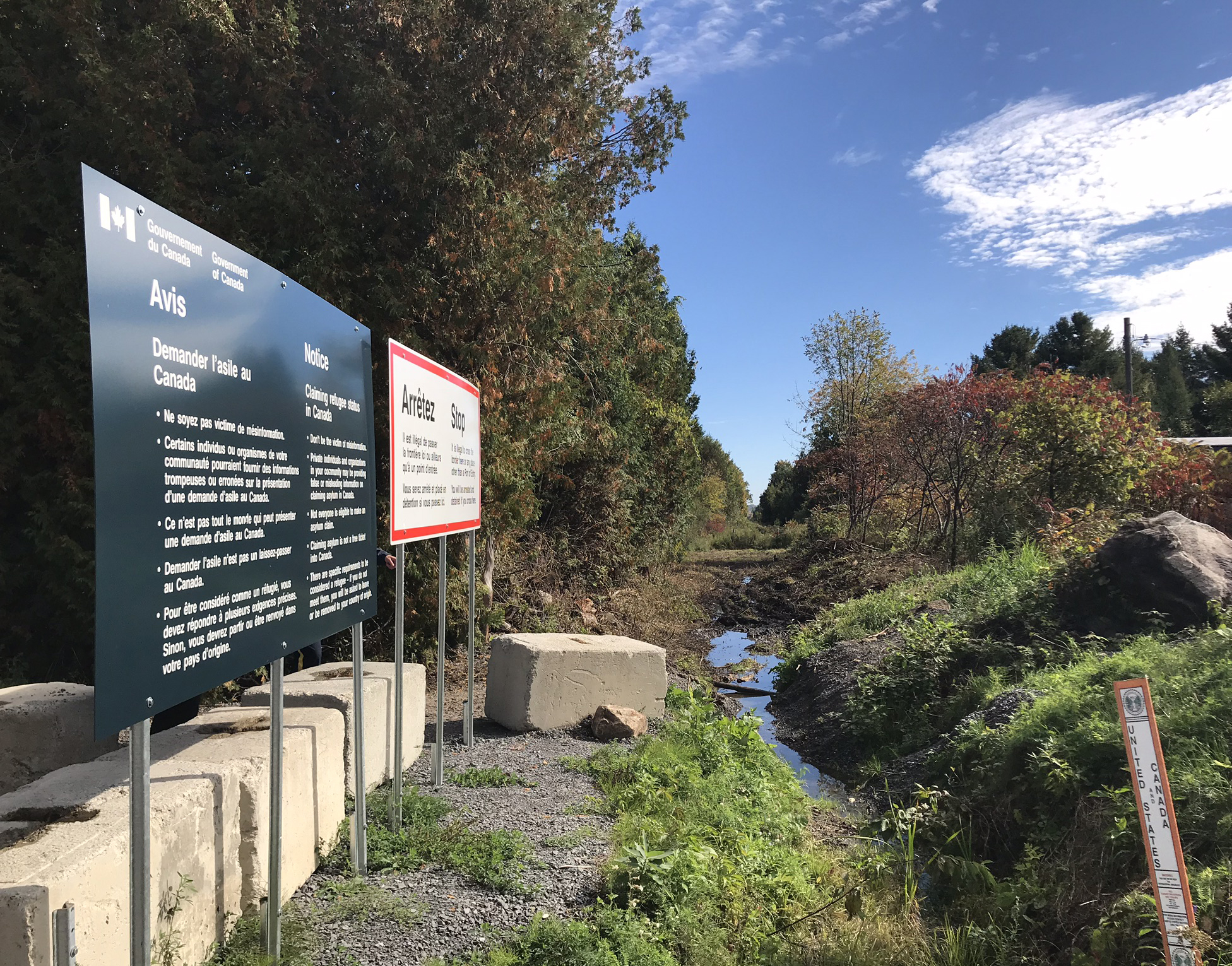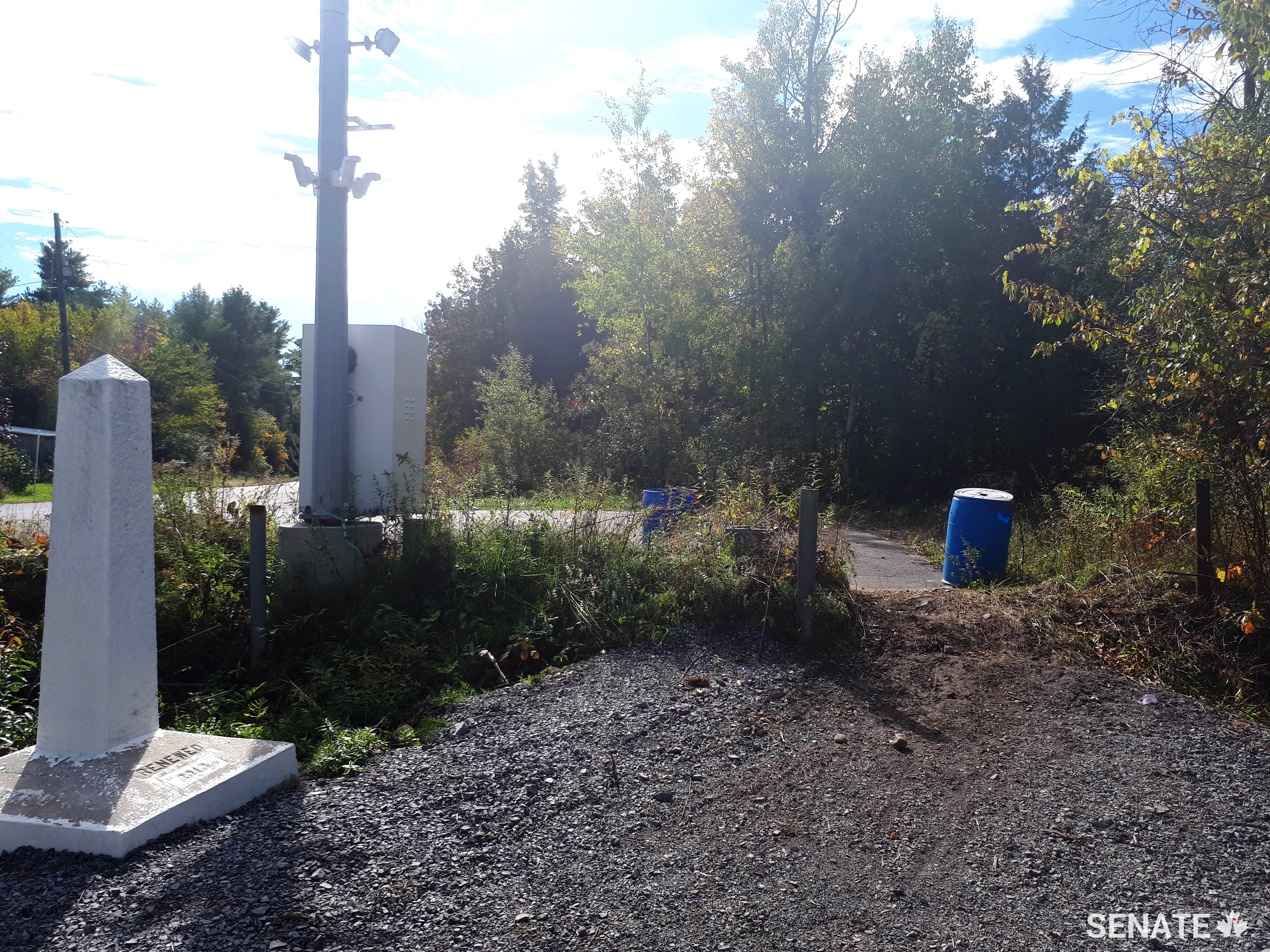Canada’s border is secure but renewal of immigration system is essential: Senators Omidvar, Pratte

Tags
The shallow ditch between Canada and the United States at Roxham Road in Quebec has many stories to tell. It is a small ditch, recently filled in with gravel by the local community so as to prevent accidents as asylum seekers haul, push and carry their belongings over to Canada.
Asylum seekers may not be arriving in the numbers of the previous peak, but they still number about 50 per day. A recent poll suggests that most Canadians are concerned about the government’s response to them.
We travelled to Roxham Road on a beautiful fall day to see for ourselves what transpires there. Is it an open border with streams of asylum seekers crossing everywhere? Or is it organized and managed by the RMCP and the Canada Border Services Agency (CBSA) in accordance with our laws? Is there capacity to deal with sudden surges or are we simply leaving things up to chance?

What we found was reassuring. The RCMP and CBSA have set up an orderly and organized system to meet the asylum seekers as they cross the border. Once they cross, the asylum seekers are taken into a (temporary) building where their identification is checked, fingerprints are taken and they are questioned. Translators are available on the phone to ensure that the questions and answers are understood by both parties.
Once the RCMP is done with its assessment, they asylum seekers are released to the CBSA for further processing, including biometric and fingerprint checks. Both the RCMP and the CBSA have provided for a certain amount of surge capacity.
The whole process is thorough and professional, conducted with respect for our laws and for the individuals.
This is in stark contrast to what asylum seekers may experience elsewhere. One of us recalls a personal experience from 40 years ago. Fleeing the bloody Iranian revolution with a long, cold and very treacherous journey out of the country. Not knowing whether freedom was possible. Standing in a small square room at the Iran-Turkish border with guards and guns drawn on all sides. There was no compassion. There was no understanding: just anxiety and fear.
This is why it was encouraging to see the professionalism of the RCMP and CBSA officers. As one RCMP officer said, “We can see the agony in their eyes, so we want to treat them with respect.” It was particularly important to see the systems that had been set up to ensure that children were safe and well cared for.
We saw a family of four cross when we were there. They don’t cross in the woods or run from the RCMP. They cross peacefully, knowing they must follow the rules if they are going to have a chance at staying.
The difficulty is not at the border; it is with the immigration process that follows. The Immigration and Refugee Board (IRB) has been underfunded for many years due to cutbacks. The current government has put more money into the system, but with the increase in asylum claims the wait times for determining status has gone from 18 to 20 months.
Also, it can take a long time to remove someone from Canada if their asylum claims are rejected. Whether we like it or not, these long delays constitute a “pull” factor for those who may not be genuine refugees, but are seeking a better life.
It is essential that the IRB works efficiently and effectively. Peace, order and good governance must not only prevail at the border, but also in the boardrooms of the IRB. More resources and more judges are essential, but so too is an institutional renewal to ensure gains in co-ordination and efficiency. This is not simple, but the government needs to take charge and propose and implement a system that is all three things: fast, fair and final. And it must do so quickly so that public confidence is restored.
Failing this, we fear immigration will become a political football going into an election next year. And too often the discussion around immigration veers into division and fear. That would be extremely unfortunate.
Canadians generally support immigration, but this support can quickly waver and wane if public confidence is not on side. Renewal of the IRB can get us there.
Ratna Omidvar represents Ontario in the Senate and André Pratte is a senator from Quebec (De Salaberry).
Note to readers:
The Honourable André Pratte retired from the Senate of Canada in October, 2019. Learn more about his work in Parliament.
The Honourable Ratna Omidvar retired from the Senate of Canada in Novembre, 2024. Learn more about her work in Parliament.
This article appeared in the Oct. 25, 2018 edition of The Toronto Star.
The shallow ditch between Canada and the United States at Roxham Road in Quebec has many stories to tell. It is a small ditch, recently filled in with gravel by the local community so as to prevent accidents as asylum seekers haul, push and carry their belongings over to Canada.
Asylum seekers may not be arriving in the numbers of the previous peak, but they still number about 50 per day. A recent poll suggests that most Canadians are concerned about the government’s response to them.
We travelled to Roxham Road on a beautiful fall day to see for ourselves what transpires there. Is it an open border with streams of asylum seekers crossing everywhere? Or is it organized and managed by the RMCP and the Canada Border Services Agency (CBSA) in accordance with our laws? Is there capacity to deal with sudden surges or are we simply leaving things up to chance?

What we found was reassuring. The RCMP and CBSA have set up an orderly and organized system to meet the asylum seekers as they cross the border. Once they cross, the asylum seekers are taken into a (temporary) building where their identification is checked, fingerprints are taken and they are questioned. Translators are available on the phone to ensure that the questions and answers are understood by both parties.
Once the RCMP is done with its assessment, they asylum seekers are released to the CBSA for further processing, including biometric and fingerprint checks. Both the RCMP and the CBSA have provided for a certain amount of surge capacity.
The whole process is thorough and professional, conducted with respect for our laws and for the individuals.
This is in stark contrast to what asylum seekers may experience elsewhere. One of us recalls a personal experience from 40 years ago. Fleeing the bloody Iranian revolution with a long, cold and very treacherous journey out of the country. Not knowing whether freedom was possible. Standing in a small square room at the Iran-Turkish border with guards and guns drawn on all sides. There was no compassion. There was no understanding: just anxiety and fear.
This is why it was encouraging to see the professionalism of the RCMP and CBSA officers. As one RCMP officer said, “We can see the agony in their eyes, so we want to treat them with respect.” It was particularly important to see the systems that had been set up to ensure that children were safe and well cared for.
We saw a family of four cross when we were there. They don’t cross in the woods or run from the RCMP. They cross peacefully, knowing they must follow the rules if they are going to have a chance at staying.
The difficulty is not at the border; it is with the immigration process that follows. The Immigration and Refugee Board (IRB) has been underfunded for many years due to cutbacks. The current government has put more money into the system, but with the increase in asylum claims the wait times for determining status has gone from 18 to 20 months.
Also, it can take a long time to remove someone from Canada if their asylum claims are rejected. Whether we like it or not, these long delays constitute a “pull” factor for those who may not be genuine refugees, but are seeking a better life.
It is essential that the IRB works efficiently and effectively. Peace, order and good governance must not only prevail at the border, but also in the boardrooms of the IRB. More resources and more judges are essential, but so too is an institutional renewal to ensure gains in co-ordination and efficiency. This is not simple, but the government needs to take charge and propose and implement a system that is all three things: fast, fair and final. And it must do so quickly so that public confidence is restored.
Failing this, we fear immigration will become a political football going into an election next year. And too often the discussion around immigration veers into division and fear. That would be extremely unfortunate.
Canadians generally support immigration, but this support can quickly waver and wane if public confidence is not on side. Renewal of the IRB can get us there.
Ratna Omidvar represents Ontario in the Senate and André Pratte is a senator from Quebec (De Salaberry).
Note to readers:
The Honourable André Pratte retired from the Senate of Canada in October, 2019. Learn more about his work in Parliament.
The Honourable Ratna Omidvar retired from the Senate of Canada in Novembre, 2024. Learn more about her work in Parliament.
This article appeared in the Oct. 25, 2018 edition of The Toronto Star.


